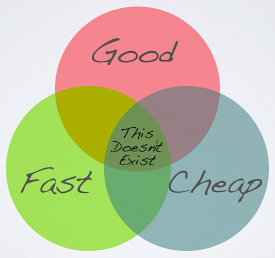The Race to the Bottom for Technology in Churches
 At a time in an industry where commoditization is leading to thinner margins and online price wars, the discussion of Good, Fast or Cheap is sorely needed — before your organization wins the race to the bottom.
At a time in an industry where commoditization is leading to thinner margins and online price wars, the discussion of Good, Fast or Cheap is sorely needed — before your organization wins the race to the bottom.
Most of us know the Venn diagram below, depicting the reality of choosing any two, but never all three, options. If Cheap is the highest priority, then the lowest priority will usually be Good — and Good will almost always suffer. The focus on Cheap is often blamed on chintzy clients, but we should be admonishing our own industry when manufacturers and vendors make price the biggest discussion point.
 Why Features Never Really Win
Why Features Never Really Win
When an innovation hits the audio, video, and lighting industry, it’s only a matter of time – usually counted in weeks or a few months – before a competitor either makes a “me-too” option or ups the ante with an even greater innovation. Great features do matter; they’re simply not the key value differentiator. This slippery slope inevitably leads to price-per-feature comparisons, which are equally ineffective.
When a company chooses to diminish the value proposition to “buy me, I’m cheap,” the race to the bottom is well underway – and this a race you don’t want to win.
Seth Godin sums this eventual reality up nicely:
“There’s always the opportunity to cut a corner, sacrifice lifestyle quality and suck it up as we race to grab a little more market share. But the problem with the race to the bottom is that you might win. You might make a few more bucks for now, but not for long and not with pride. Someone will always find a way to be cheaper or more brutal than you…the race to the top is focused on design and respect and dignity and guts and innovation and sustainability and, yes, generosity when it might be easier to be selfish.” – Seth Godin
At our industry trade shows we see this bottom-focused marketing propaganda emblazoned on booths – and it’s almost always a bullet point list of new or enhanced features. This is the lowest rung on the marketing chain, because it’s the easiest to succinctly showcase on a convention floor or expo hall. The problem with this technique is that the value proposition lead is buried. Felt-needs are almost always (always?) a better solution for firms wanting to provide more than a widget as a pure commodity sale.
Equally effective in the trade-show environment and on your website, felt needs identify your products/offerings with the shared values or felt pain of the audience.
Here’s a fictional example comparing features and benefits against felt-needs value proposition statements:
| Features/Benefits | Felt-needs Value Proposition |
|---|---|
| 2x Faster performance | Get more done in half the time |
| New quiet motor assembly | Eliminates noise distraction for quiet venues |
| Redundant power supplies | Peace of mind redundancy |
| Inexpensive (consumable) replacement | Low cost of (X years) lifetime ownership |
| Starting at only $$$ | Maximize your budget with affordable technology |
Avoiding the Race to the Bottom
It important to be clear here and make a distinction between value and price. The value of something can be stated as either objective or subjective. As such, a $1 bill will always be worth $1 because the U.S. government backs it at the face value – the objective value. Subjective value is at the intersection of demand and supply; how badly a person wants/needs something against the availability for that item.
When price is the key selling point, you’re running a losing race to the bottom of the sales pipeline, where you lose when you ‘win’.
The price vendors choose for technology is often rather arbitrarily set in comparison to other similar technologies. In this model, price has nothing to do with the value of the solution. What if your technology solves a problem in a unique way for a certain segment of a market? That market segment will see greater value in your solution than another person who doesn’t have the same requirements in a different market segment.
“Price is what you sell when you can’t sell value.” – S. Anthony Iannarino
Here are a few ways to avoid the trap of running the race to the bottom:
- Understand your brand’s value and identify your product’s value differentiation – and then stick with it, refusing to fall into the trap of features/benefits comparisons.
- Know thy audience and describe/define each vertical market’s value quotient: the combination of product desirability and the premium price at which they will buy. Even within a vertical, such as the House of Worship market, differentiate the value quotient for churches based on their size and technical staffing levels.
- Revisit and rethink your pricing model based on the value quotient, with 100 percent authenticity and transparency. No gimmicks, just value and truth.
The Only Time Low Prices Really Win
Amazon co-founder Jeff Bezos has a now-famous quote in a Business Week article:
“‘What we are doing is offering premium products at non-premium prices,’ Bezos says. Other tablet contenders ‘have not been competitive on price’ and ‘have just sold a piece of hardware. We don’t think of the Kindle Fire as a tablet; we think of it as a service.’”
If you have a large enough solutions ecosystem to make your profits from services instead of products, then you don’t have to worry about low-priced technology because it is just the break-even or loss-leader for your recurring revenue service offerings. This is how Amazon uses their Kindle Fire (and, as of this writing, the Kindle Fire HD) to go head-to-head against the much more expensive (and feature rich) Apple iPad; Amazon’s plan is to make enough revenue at higher margins on selling content and subscriptions. This justifies the significant price difference between the iPad and the Kindle Fire line. And, hey, if that’s your market opportunity then your value proposition isn’t the device itself, but the simplicity of making the device cost effective so that the client understands the real value: nearly unlimited content.
I’m fairly confident that even some of the biggest names in our industry are not in this position. And, with that understood reality, we’re back to defining the value differentiation, value quotient, and value proposition to change the industry from a myriad of “me-too” comparisons to one-of-a-kind value offers that identify the felt needs of your market segments.
Where can the A/V/L industry most readily redefine value-based marketing and selling? Comment below.





